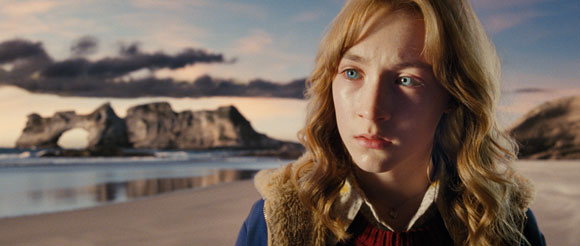The Lovely Bones

Peter Jackson’s The Lovely Bones begins as an intriguing concept and degenerates quickly into a visual effects spectacle of mediocrity. Based on Alice Sebold’s novel, the film tells us the fictional story of Susie Salmon (Saoirse Ronan), a teenage girl raped and murdered by a neighborhood man.
The film introduces us briefly to her family life, mostly her closeness to her father who meticulously crafts bottle ships in his spare time. Susie has a crush on her classmate, Ray Singh (Reece Ritchie). Before they have a chance at a first date, she’s distracted on her walk home by George Harvey (Stanley Tucci, being as creepy as humanly possible) who lures her into an underground shack. The story takes place in 1973, a time when parents were far more trusting to let their children out of their sight. The film, contrary to the studio’s inept advertising campaign, is less about the investigation into her death than about the way in which the incident impacts the lives of her friends and family, including her sister, Lindsey (Rose McIver), who grows up to be a little tougher and wiser to the neighborhood perils, always sensing something a little off about Mr. Harvey.
One critical failure, however, of Peter Jackson’s first directorial effort since King Kong—a seemingly autobiographical film about a director obsessed with spectacle over substance at tremendous cost—is that the characters, peripheral to Susie’s life but central to the narrative, are largely undeveloped or ignored. Consider the wife, Abigail (Rachel Weisz), whose stages of grief, marital and social withdrawal could have made a fascinating character study. In the book she has an affair with the police detective, Len Fenerman, played here by Michael Imperioli. She’s left mostly on the sidelines to have an emotional breakdown and be sent off to her parents while dad, Jack (Mark Wahlberg), drives everyone up the wall with his obsessive-compulsive desire to play gumshoe. We also meet Abigail’s alcoholic, chain-smoking mother, Lynn. While there’s a sense of a deeper, troubled relationship between mother and daughter, it’s only glossed over in favor of comical exposition involving the stereotypically crazy mother-in-law with the drinking problem.
Mr. Jackson has also attempted to preserve most of the story from the book, and that may be another flaw. Some things don’t always translate well from page to screen, as he stated in interviews concerning the heavily-pared Lord of the Rings trilogy. Ms. Ronan’s voice-overs are delivered ponderously with flowery prose that reads as if the passages were lifted directly from the book. I don’t, however, feel this is Ms. Ronan’s fault. It’s a matter of bad direction. For her part, Ms. Ronan demonstrates the capacity to act superbly, ranging in emotion from happiness to infatuation, suspicion, fear, loneliness and terror.
The two largest complications, however, are conceptual. The film begins in a conventional style, taking us in a quick montage through the years as the newlywed Mr. and Mrs. Salmon become parents, experiencing a shift in reading material and bedtime activities. Immediately after Susie’s murder occurs a brilliant visualization: Susie keeps running, her body cutting through fog like a spectre. After she returns to find a desolate town, bathed in gloomy moonlight, there isn’t a person in sight but she hears their voices. We then realize she’s in a netherworld parallel to ours. She finds herself in a bright white room where Mr. Harvey, his face creepily covered by a washcloth, is bathing. He rinses the last remnants of evidence from his body and, with that, Susie disintegrates to dust only to reappear in her personal heaven. Up to that point, the use of visual effects was brilliant. But the movie veers off into whimsical imagery entirely incongruous with the tone of every other scene. The problem isn’t the surreal nature of the environments, with its rainbows, flowers and other childlike wonders that might occupy a fourteen year-old’s idea of heaven. It all feels synthesized. There’s no organic chemistry between Susie and her environment, the way there was in the lush worlds of What Dreams May Come. That film’s versions of heaven and hell were equally balanced against one another in tone and style.
Finally, there’s the plot. Child abduction and murder tends to be, understandably, a sympathy trigger like no other. This is apparent in journalism, where in any slow news week. Flip the channels and you will find story after story of Missing White Woman or Missing White Suburban Teenage Sweetheart, exploited for ratings. There’s absolutely no question that these events are horrible, but for journalists and filmmakers this is shooting fish in a barrel. Perhaps the story, characters and visual cohesiveness suffered because Mr. Jackson felt assured he was dealing with an emotionally-manipulative subject that would preoccupy the audience enough to skew perception and make any real critical judgment of the film’s merits or flaws nearly impossible. Critics never endure more backlash from readers than when they attempt to deconstruct a film about which whose audience is extraordinarily passionate. Whether I will need a facemask and shoulder pads remains to be seen, though, because the film redeems itself—barely—with an unconventional outcome likely to leave audiences feeling dissatisfied.
 The Lovely Bones • Dolby® Digital surround sound in select theatres • Aspect Ratio: 2.39:1 • Running Time: 135 minutes • MPAA Rating: PG-13 for mature thematic material involving disturbing violent content and images, and some language. • Distributed by Paramount Pictures
The Lovely Bones • Dolby® Digital surround sound in select theatres • Aspect Ratio: 2.39:1 • Running Time: 135 minutes • MPAA Rating: PG-13 for mature thematic material involving disturbing violent content and images, and some language. • Distributed by Paramount Pictures